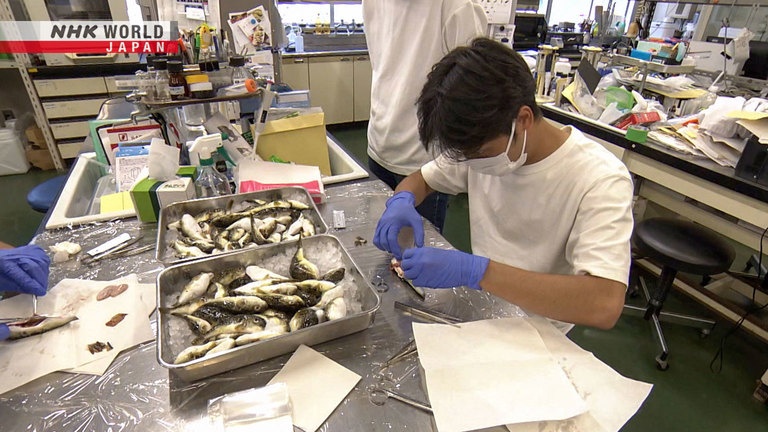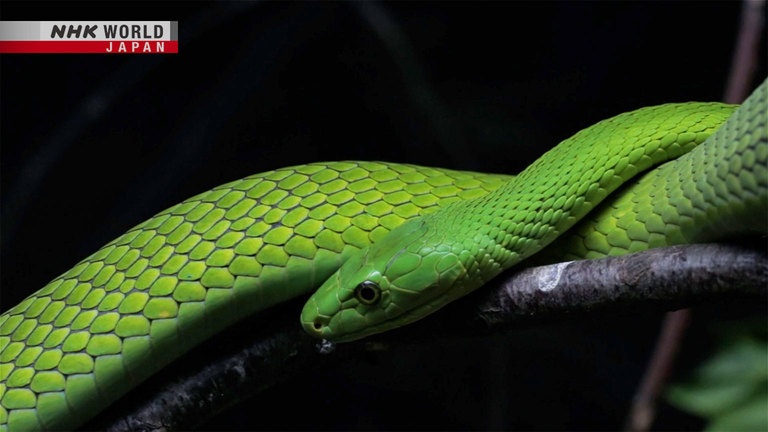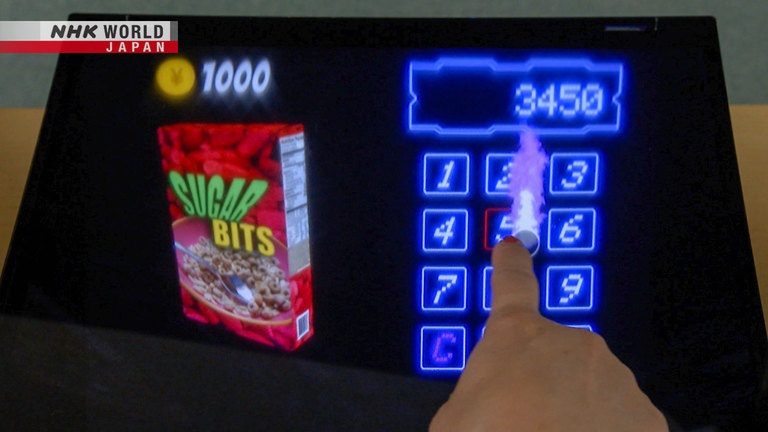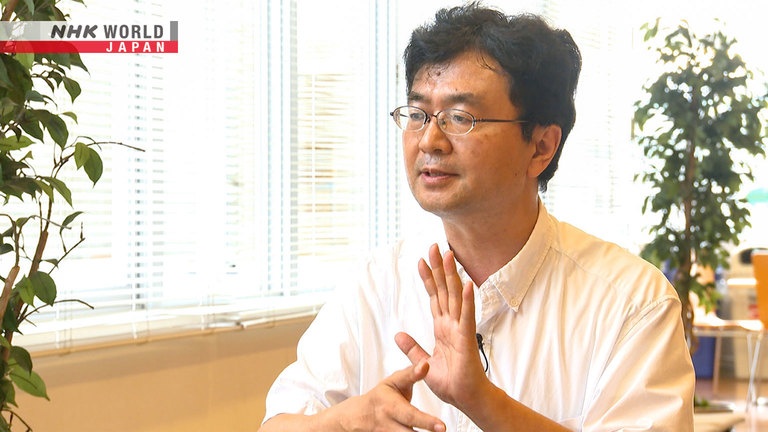Poisons in the Animal Kingdom
There are many dangerous creatures in the natural world that use poison for self-defense or for hunting, such as poisonous snakes, spiders and scorpions. It is said that there are more than 200,000 species of poisonous animal on Earth, each with varying degrees of toxicity. Research is currently underway around the world to make these animal poisons useful to humans. For example, a major feature of biotoxins is that they target particular molecules. This "specificity" can produce different results on different targets. This feature is being applied in the development of drugs with minimal side effects and pesticides that only attack pests. Researchers explore the possibilities of a "treasure trove" of poisons.
[J-Innovators]
Using a distinctive optical design to create a "touchless" touch-panel display.




Transcript
Poison.
In the 3.5 billion years since life first appeared on Earth, many animals have evolved to produce poisons.
Some to catch prey, and some to protect themselves from predators.
Poisons are a fact of survival in the natural world.
Venom is just a very good Swiss army knife.
It's a chemical weapon that has been used by many lineages.
Recent findings have revealed some new and surprising things about animal poisons.
Such as poisons that only affect particular targets.
Research is underway around the world to use these properties to treat diseases and get rid of pests.
We're using what these creatures evolved to use.
There's a chemical treasure trove in animal poisons.
Animal poisons and venoms, diverse and potent substances, courtesy of evolution.
Today we'll look at their amazing powers!
And later, in our J-Innovators segment,
Michelle brings us a report about the developer of a new sci-fi style display
that projects images in a way that seems almost impossible.
Hello and welcome to Science View.
I'm your host Tomoko Tina Kimura.
Today, we're talking about poisons in the animal kingdom.
And with us is Mr. David Hajime Kornhauser, Director of Kyoto University's Office of Global Communications.
- Thank you for joining us.
- It's a pleasure to be here.
Poison is about the last thing in the world anybody would want to experience.
Fortunately, I have never been bitten by a snake or stung by a bee.
Wow, that is really lucky.
- I have been stung by jellyfish in the ocean. It was extremely painful.
- I'm sorry to hear that.
Mosquito bites are really common, when it comes to talking about "poison."
The itchiness after a mosquito bite is an allergic reaction to toxins the mosquito releases into the body.
I have certainly been bitten by mosquitos a number of times.
Which means that most people have some experience with animal poisons.
That's right. Poisonous creatures are not at all unusual in nature.
And some have poisons much stronger than the poisons we humans create through chemistry.
Animal poison is stronger than synthetic poison?
It can be. For example, it's said that 2 to 3 hundred milligrams of the poison Potassium Cyanide is enough to kill an adult.
- But the poison in a pufferfish is 1,000 times stronger than that.
- That's quite scary.
So, how did animals come to be poisonous in the first place?
This first video is about the history of animal poisons.
With a collection dating back 250 years, London's Natural History Museum.
It houses some 80 million specimens and preserved animals and from around the world.
Principal Researcher Dr. Ronald Jenner has been studying animal poisons for many years.
I study venoms of worms called blood worms, I study pseudo-scorpions,
I have studied aquatic predatory venomous crustaceans.
They offer insights into venom biology and evolution.
The museum's storage facilities hold priceless preserved specimens, some of them poisonous.
He showed us a few from the collection he's now working with.
What's first is sort of one of my favorites because I happen to work on centipedes.
If you look at the front end, they deliver the venom with that modified pair of walking legs.
They look like they've been in the gym a lot, and they're big because they contain this massive venom glands,
and the mode of operation of this type of thing is to paralyze, but they can inflict a very painful bite in defense.
This is a very large venomous lizard.
This is in fact a Komodo dragon.
And yes, they are venomous as well.
They have large venom glands in the lower jaw, and they open near the base of their pointy serrated teeth.
And they use their venom for predation.
So they will bite a large mammal like a buffalo or deer.
And they would inflict wounds.
And the venom actually seems to have the purpose of causing shock,
because the animal's blood pressure will plummet and they go into shock.
They will get problems with blood clotting, and they can get very painful gut cramps as well.
Jenner's group analyzed published data from around the world
to estimate how many times venomous animals have occurred throughout the history of evolution.
Their findings are seen in this diagram showing the evolutionary history of venomous animals.
It's a tree showing the stages in evolution where each venomous animal first appeared.
For example, the common ancestor of spiders and scorpions was non-venomous.
So, they developed venom separately, after they'd split into two different creatures.
Lizards and snakes, on the other hand, are thought to have diverged from a common venomous ancestor.
They found these newly poisonous animals have occurred in separate lineages...
...over 100 times!
Those lineages then branched out, bringing the total number of poisonous animals to around 200,000 species.
So it's evolved so frequently and it's present in so many species because it is so very useful.
Jellyfish for instance, they are not as fast as a fish yet many of them eat fish.
And the way they can do is because they have a powerful, paralyzing venom which they can subdue much stronger and faster prey.
So the ability to evolve the chemical weapon like that
allows you to take the evolutionary competition out of the physical arena and put it in a chemical arena,
and that means that physically weak creatures can actually do a lot.
When we talk about poisons in general,
we tend to think of the venom of dangerous and naturally strong creatures that attack.
But less-aggressive animals also evolved to produce other sorts of poison as a way to protect themselves.
That's right. Different poisons contain different toxins, and are used by animals in different ways.
But basically, either for attacking or for self-defense.
Attacking to catch prey is what naturally comes to mind.
What kinds of defensive poisons are there?
Things like poisonous frogs.
The poisons on the outside of their body have an unpleasant taste that warns predators not to eat them.
These defensive animal poisons are usually already in place, and effective as is.
- But animals that attack with poison also need some way to get that poison into their victims, like stingers or fangs.
- That's a big difference.
And just because an animal is poisonous, it doesn't mean they have an endless supply of poison.
How long does it take an animal to regenerate its poison, once they've used it?
There's a poisonous snake endemic to Japan called the "habu."
It takes several days to several weeks to regenerate its poison.
So, for example, if it uses its poison once, but fails to catch its prey,
it's left there powerless, and presumably hungry.
It has to use its remaining energy to replenish its venom, so it can hunt again.
Poison is a powerful weapon in the animal kingdom, but using it means significant risks.
That's right. And what about pufferfish?
Also known as "fugu," they're a famous delicacy, and they're also extremely poisonous.
Would you categorize that as offensive or defensive poison?
I'm not sure. I know they're poisonous to humans.
But they don't attack people, so they don't seem to be offensive.
On the other hand, it seems a little too late for defense, once you're already on the dinner table.
That's right. Pufferfish poison is strong enough to kill a person.
The poison is called "tetrodo-toxin."
Do you remember where it's located?
Yes, it's in the internal organs, which is why chefs have to be so careful when cutting them up.
That actually seems odd...
because why would pufferfish have evolved an internal poison that doesn't protect them when they're still alive?
Right. It'd been a mystery for years.
But now we have a pretty good idea why.
Nihon University professor Shiro Itoi has unraveled a mystery of pufferfish poison.
Throughout the year, his team caught pufferfish and measured how much poison they had inside, to detect seasonal changes.
Pufferfish don't produce their own poison.
They get it by eating other marine animals.
Such as flatworms, known as Plano-cera multi-tentaculata, that contain the deadly poison tetrodo-toxin.
Which begs the question, are pufferfish okay eating poison?
In most animals, tetrodo-toxin has a poisonous effect when it binds to proteins in the body.
But, in pufferfish, the proteins have a different shape
that makes it difficult for the tetrodo-toxin to attach, limiting its effect.
Itoi's study revealed a particular time of year when female pufferfish eat a lot of flatworms.
In this season, the females have a lot of poison.
The poison level in females spikes in April, just before the spawning season.
And two-thirds of that is concentrated in the ovaries.
Itoi captured special images of newly-hatched baby pufferfish.
The red part is the tetrodo-toxin.
We can see it's distributed across the exterior of the body.
When a predator goes to eat the hatchling...
...it tastes the poison and spits it out.
So, it seems this poison is less about protecting the adults and more about protecting the babies.
It's the most vulnerable time in their lifespans.
It certainly seems this poison protects them.
So, the mother pufferfish eats that poison to protect her newborns from predators!
That's right. There'd been speculation before,
but this was the first time it was demonstrated that pufferfish use that toxin to preserve their species.
It was big news, reported in newspapers and other media outlets.
So far, we've been talking about uses of animal poisons that are harmful, at least to the victim.
But these can also be used in beneficial ways, possibly leading to medications for humans.
Yes. Animal poisons are comprised of multiple toxins, each of which acts on a specific target molecule.
And those toxins are quite particular about which species they act on, affecting some animals but not others.
Researchers are looking for ways to apply that "specificity" in medicine and other fields.
How might animal poisons be of use to humans?
Let's look at two projects exploring the possibilities.
Poison to save lives.
That's what animal toxins researcher Dr. Nicolas Gilles is working on at a French national research institute.
A high selectivity means that the toxin will act only on your receptor of choice
and not on other receptors to minimize side effect.
When I found a good toxin which correspond to what I want against the disease,
I'm trying to develop it as a drug candidate.
He's studying a highly venomous African snake known as the "Green Mamba."
Its bite can kill a person in as little as 30 minutes.
Gilles wants to harness the properties of its toxic venom
to develop a drug to treat "Polycystic Kidney Disease," also known as "PKD."
Normally, when a particular hormone attaches to certain receptors in the kidney,
a signaling substance is released that cues the kidney to condense the urine.
In PKD patients, however, the signaling substance causes irregular cell division,
forming cysts that impede the kidney's functioning.
Gilles discovered a mamba toxin that fits snuggly into this receptor,
preventing the hormone from attaching to it, and reducing the release of the signaling substance.
He ran an experiment in which mice with PKD were treated for three months with the mamba toxin.
We demonstrated that mice, developed 30% less of cyst.
The kidney function is better on the group treated with the mamba-quaretin.
So those results demonstrate that the mamba-quaretin can block the cyst in this model.
Gilles expects people suffering from PKD will one day be treated with mamba toxins!
Meanwhile, another researcher is studying venoms that use different toxins depending on the species of animal attacked.
Kyoto University associate professor Masahiro Miyashita.
Yes, I've been stung before, at the tip of my finger.
It hurt a little, But I think these little guys are cute.
He's studying how scorpion venom could be used in agriculture.
The most useful thing for us is pesticides.
Bees are very helpful insects.
The pesticides don't work on bees.
They work on pests, insects that eat crops.
Scorpions kill their insect prey with their venomous sting.
That venom is thought to contain over 100 different toxins that act on an insect's muscles and nerves.
When researchers extract a particular toxin, and inject it into a cricket...
30 minutes later...
This is typical. It can't stand up.
The thorax area is impaired.
This toxin has been shown to act on the nervous system of crickets.
Moreover, they say it may act on crickets and grasshoppers in particular.
There are 100 to 200 different peptides
in the venom of the dwarf wood scorpion.
We're separating them out to figure out
which ones affect which insects.
Miyashita hopes this research will lead to pesticides with less impact on the environment.
It makes sense for us to use what
these creatures have evolved to use.
There's a chemical treasure trove
lying dormant in scorpion poison.
This reminds me of a saying in Japan, "dokuyaku henjite kusuri to naru,"
which translates to "poisons change into medicines."
It means even things that initially cause trouble can become beneficial, depending on how you use them.
Every cloud has a silver lining.
We could see poison and medicine as two sides of the same coin.
Maybe a blessing in disguise?
Japan doesn't have as many poisonous animals as some other countries.
But we do have a few highly poisonous creatures, like wasps and "habu" snakes.
Could those poisons be used to develop new drugs?
Well, for example, with the habu snake venom, like Komodo dragon venom, contains toxins that inhibit blood clotting.
These are known as "hemorrhagic" toxins which cause the victim to bleed uncontrollably.
There seems to be a good chance these could be used beneficially
to develop therapeutic drugs to fight diseases associated with blood clotting, such as heart attacks.
Let's hope so! That would be wonderful.
Next up, in our J-Innovators segment, a report about the developer of a new sci-fi style display.
OK, what's on my schedule for next week:
I have two narrations... OK!
Hi! I'm Michelle! This is a scene that you see on sci-fi movies, right?
But it is something that's going to happen in the very near future.
Today, I'm going to introduce you to an innovator who has developed a revolutionary device.
We visited a venture company that plans and develops optical components in Higashi Osaka City, Osaka Prefecture.
Hello, I'm Michele Yamamoto.
Hello, I am Maekawa from Parity Innovations.
Pleased to meet you.
Satoshi Maekawa, the representative of the company is today's "Takumi" or Innovator.
He showed us a device that can project images in the air.
Let's begin. Here we go!
Wow. What's this?
It's floating.
It is difficult to convey the sense of perspective from the TV screen,
but if you look at it with your two eyes, the dandelion clearly appears to be floating in the air.
The dandelion is standing like this,
and it looks three-dimensional.
Yes. The surface is right here.
How is this possible?
This is the demo unit showing what's inside.
Inside, there is a liquid crystal display mounted at an angle,
but the image of a dandelion projected here appears to float about 10 cm above the surface of the device.
Why does this occur? How do we recognize where things are in the first place?
For example, when we look at a dandelion in a field,
we recognize the position of the flower by catching its reflection
based on the slight difference in the angle of the light that is reflected from the dandelion.
If we take out one of the dandelion's reflections, we get this image.
By placing an object between this point of light and the viewer's two eyes,
the Takumi was able to control the way light travels
and succeeded to make the dandelion appear in a different location than it is.
The secret is in this translucent board that the Takumi invented...
Wow, it's kind of grainy.
It feels rough to the touch.
Yes, extremely grainy but fine.
When you look at this rough board under a microscope,
you can see that cubic protrusions are lined up in rows.
This is the "two-sided corner reflector array," the optical element that produces images in the air.
The cube is made of resin, with each side only about 0.1 mm.
The light entering the cube is reflected by two surfaces at 90-degree angles,
and exits in a plane-symmetrical direction with respect to the plane on which the cubes are lined up.
By arranging these elements in a regular pattern,
it is said that countless beams of light can be concentrated at a single point.
But is that really possible?
We asked Maekawa to reproduce this situation in an experiment.
This is a simple experiment in which an acrylic cube of 5 cm per side is used as a two-sided corner reflector array.
There are five lasers, and the beams
are all collected in one place.
There is a point of light here, which is reflected
twice on these two-sided corner reflectors.
It assembles in the air once more,
and from there, it diffuses and spreads out again.
I see. So, the image that we are seeing
appears right here where the light converges.
Yes, that's right. The image is formed here.
So, by looking at the light over here,
it appears as if this is the image point.
The area in front of the cube where the light converges is where the dandelion on the LCD screen.
The light emitted from there reflects off the cube and converges at a point in the air, which is where the same image appears.
The device is also designed to be more practical.
Could you try touching the fluff with one finger?
Aah! How surprising! How can it be?
The sensor over here detects where
your finger is, two-dimensionally.
The image on the display moves with the
position of your finger, making it a touch panel.
By incorporating a motion sensor using infrared light,
it detects the movement of your finger and moves the image on the display accordingly.
With this sensor, the possibilities for image display in mid-air have also greatly expanded.
For example, here is a "floating piano" that links the image of a keyboard with a motion sensor.
This is a prototype of a contactless touch panel for ordering products.
Since it is hygienic, many people have high expectations for this product,
especially at sites where food products are handled.
Maekawa studied physics at university and did research on artificial intelligence at graduate school.
Later, at a national research institute, he worked on three-dimensional TVs.
That was when he thought of aerial imaging technology.
When I was looking at a diagram of light rays,
I came up with the idea of placing a mirror.
But only placing a mirror, various rays of light
would come out and it wouldn't work properly.
But with mirrors on either side and viewing at an angle,
you only see the light that forms the image.
Over the next five months, Maekawa created a prototype.
However, he was still unable to produce a clear image.
This is an early optical element.
It was made of metal and was difficult to process precisely, so the aerial image was not as clear as today's.
Creating aerial images required optical elements as precise as precision as a camera lens.
So, at the time, he could barely produce an optical element 5 cm per side.
Changing the material to resin and using die molding produced the required precision.
And it also opened the way for mass production, enabling the molding of large 38-cm-square pieces.
20 years have passed since he first got the idea.
The device developed by Maekawa is now used in a variety of places.
We asked him about the future possibilities of this technology.
Aerial imaging is just light, so window glass or even
aquarium glass will not pose a barrier.
You could project an outside interface for something
displayed inside a shop window.
People can touch it outside, or even inside a car.
You don't have to open the window to operate it.
Maekawa envisions a future where aerial images are used by everyone, everywhere in our living spaces.
Well, that was some display!
Indeed. It doesn't necessary look that great when you are rewatching it on another screen.
But, if you're in the room, it looks like the flower is there in front of you.
Today we've been looking at poisons in the animal kingdom.
Can you give us your final thoughts?
Well, it's sort of ironic if humans end up protecting ourselves with the same poisons that might've otherwise killed us.
We tend to think of poison with the skull and crossbones simbol, as something that shouldn't be touched.
But like the researcher said,
there could be a treasure trove waiting for us to discover and use in ways we'd never imagined.
I'm particularly looking forward to poisons leading to medical treatments.
Yes, me too! I'm especially interested in that research that could lead to new medicines. Let's hope it goes well!
Mr. Kornhauser, thank you for joining us today.
Thank you so much for having me.